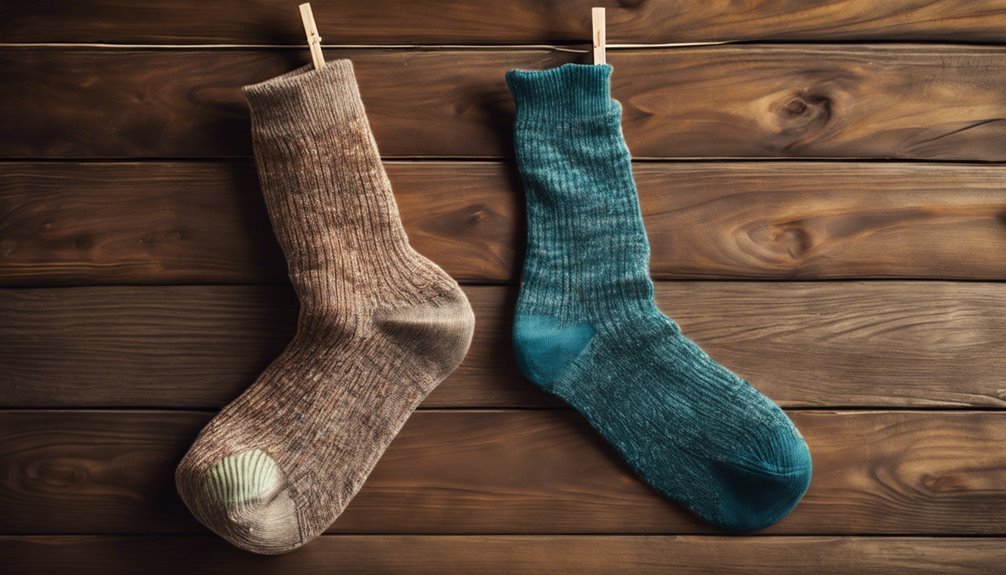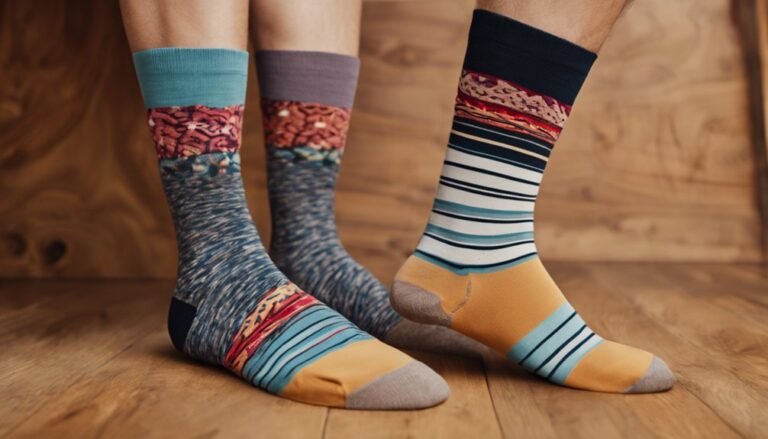Synthetic vs. Natural Fiber Socks: Pros and Cons
When comparing synthetic and natural fiber socks, consider their unique strengths and weaknesses. Synthetic fibers excel in moisture-wicking and durability, making them a great choice for high-intensity activities. Natural fibers, like wool, offer superior comfort and temperature regulation but may retain some moisture. Both types have their merits, and blends can combine the best of each. Understanding these factors can help you make the right choice for your needs; further insights await you.
Overview of Synthetic Fiber Socks

When you consider the performance of socks, synthetic fiber options often stand out due to their engineered properties. These materials, such as polyester and nylon, provide excellent moisture-wicking capabilities, enhancing comfort features during rigorous activities. They're lightweight and durable, making them suitable for both casual and demanding environments. In a price comparison, synthetic socks typically offer a more budget-friendly option than their natural counterparts, allowing you to stock up without breaking the bank. Additionally, their quick-drying nature guarantees that you can enjoy freedom from discomfort, especially in variable weather conditions. While they may lack the breathability of natural fibers, synthetic socks excel in performance, making them a practical choice for those who prioritize functionality and value.
Benefits of Natural Fiber Socks
While synthetic fibers have their advantages, natural fiber socks offer unique benefits that many users find appealing. One major advantage is their comfort factor; materials like cotton, wool, and bamboo provide a soft, breathable feel against your skin. This enhances your overall wearing experience, especially during extended periods. Moreover, natural fibers excel in temperature regulation, allowing your feet to stay warm in cold conditions while remaining cool in warmer weather. This adaptability contributes to a more comfortable experience, reducing the risk of blisters caused by overheating. Additionally, natural fibers often possess antimicrobial properties, which can help minimize odor. Overall, choosing natural fiber socks can lead to a superior and more enjoyable sock experience, aligning with your desire for freedom in comfort.
Comparing Moisture-Wicking Properties
Although both synthetic and natural fiber socks aim to keep your feet dry, their moisture-wicking properties differ considerably. Understanding these differences can enhance your comfort during various activities.
- Synthetic fibers (like polyester and nylon) excel at moisture management, rapidly pulling sweat away from your skin.
- Natural fibers (such as merino wool) offer decent moisture control, but they can retain some moisture, impacting temperature regulation.
- Blends of synthetic and natural fibers can provide a balanced approach, combining the best features of both materials for peak performance.
When choosing socks, consider your activity level and environment. For high-intensity activities, synthetic options may be preferable, while natural fibers could be better for moderate conditions, balancing comfort and moisture management.
Durability and Longevity: Which Material Wins?

Moisture management is just one aspect to contemplate when evaluating sock performance; durability and longevity are equally important. When it comes to wear resistance, synthetic fibers generally outperform natural fibers due to their engineered strength and resilience. However, natural fibers often provide a more comfortable experience, albeit with a shorter fabric lifespan.
| Material Type | Wear Resistance | Fabric Lifespan |
|---|---|---|
| Synthetic | High | Medium |
| Merino Wool | Medium | High |
| Cotton | Low | Low |
| Nylon | High | Medium |
| Bamboo | Medium | Medium |
Ultimately, if you seek socks that endure harsh conditions, synthetic options may be your best bet. For comfort and sustainability, natural fibers could be worth the trade-off.
Environmental Impact of Sock Materials
The environmental impact of sock materials is a critical consideration for eco-conscious consumers. When you're choosing socks, think about the following factors:
- Sustainable Materials: Natural fibers like organic cotton or bamboo are biodegradable, reducing landfill waste.
- Production Footprint: Synthetic fibers often require petroleum-based resources and energy-intensive processes, contributing to higher carbon emissions.
- Recycling Practices: Socks made from recyclable materials can be repurposed, decreasing environmental strain.
Frequently Asked Questions
How Do Synthetic and Natural Fibers Affect Sock Odor?
When selecting socks, consider how fiber types influence odor retention. Synthetic fibers often excel in moisture management, reducing bacteria growth, while natural fibers might retain more odor due to their absorbent nature. Choose wisely for freshness.
Can I Machine Wash Both Types of Socks?
Yes, you can machine wash both types of socks. For ideal sock care, use cold water and gentle cycles. Always follow washing tips on labels to maintain quality and prolong their lifespan.
Are There Hypoallergenic Options for Synthetic or Natural Fiber Socks?
If you're seeking comfort without compromise, hypoallergenic materials are available for both synthetic and natural fiber socks. They cater to skin sensitivity, ensuring your feet feel as free as a bird, no irritation in sight.
What Are the Price Differences Between Synthetic and Natural Fiber Socks?
When considering cost comparison, synthetic socks often present a lower initial price, but their fiber longevity might not match that of natural options, potentially leading to higher long-term expenses. Balance your choice with durability in mind.
How Do Different Sock Styles Affect Fiber Choice?
Did you know 60% of athletes prefer specific sock styles for performance? Choosing the right fiber impacts durability; thicker crew socks may favor synthetic materials, while lightweight styles often benefit from natural fibers for breathability and comfort.







